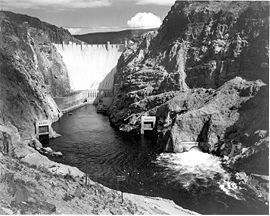once known as Boulder Dam, is a concrete arch-gravity dam in the Black Canyon of the Colorado River, on the border between the US states of Arizona and Nevada. It was constructed between 1931 and 1936, and was dedicated on September 30, 1935, by President Franklin Roosevelt. Its construction was the result of a massive effort involving thousands of workers, and cost over a hundred lives.
Since about 1900, the Black Canyon and nearby Boulder Canyon had been investigated for their potential to support a dam that would control floods, provide irrigation water and produce hydroelectric power. In 1928, Congress authorized the project. The winning bid to build the dam was submitted by a consortium called Six Companies, Inc., which began construction on the dam in early 1931. Such a large concrete structure had never been built before, and some of the techniques were unproven. The torrid summer weather and the lack of facilities near the site also presented difficulties. Nevertheless, Six Companies turned over the dam to the Federal government on March 1, 1936, more than two years ahead of schedule.
Hoover Dam impounds Lake Mead, and is located near Boulder City, Nevada, a municipality originally created for workers on the construction project, about 30 miles (48 km) south of Las Vegas, Nevada. The dam's generators provide power for public and private utilities in Nevada, Arizona and California. Hoover Dam is a major tourist attraction, and U.S. 93, a heavily travelled road, runs along its crest. In late 2010, through traffic will be rerouted onto a bypass presently under construction, and the dam roadway will be restricted to use by visitors.
For his history of a famous piece of infrastructure, Hiltzik selects one without compare. Decked out in art deco, the Hoover Dam is a beautiful immensity that awes throngs of visitors, and it boasts a construction epic reflecting Depression-era America: the first to impound the Colorado River, the dam is both product and symbol of the politics of water rights in the American West. It is the 1920s iteration of the latter on which Hiltzik, a business writer for the Los Angeles Times, embarks in his fascinating account of the genesis of the Boulder Canyon Project, as the enabling congressional act called the yet-unnamed dam. Starting the story at the torrid desert job site, Hiltzik recounts the rigorous organization of the project by the contract-winning consortium and its engineering chief, Frank Crowe. If Crowe's solutions to technical problems were audaciously titanic, the labor practices of his bosses were pitiless. Strikes were crushed; slack safety resulted in numerous deaths; and a whites-only hiring policy prevailed. Astutely conveying the characters of its creators, Hiltzik marvelously captures the times of the Hoover Dam. Read More on this Colossus: Hoover Dam and the Making of the American Century

I found it interesting how your notes only focus on website..
ReplyDeleteโคนัน
I found your blog very informative and helpful on similar note you can also check this http://crbtech.in/civil-Training/ which help civil engineering freshers. Thank you.
ReplyDeleteThank for providing good information for site,Thanks for your sharing.
ReplyDeleteหนังออนไลน์
Good information on blog. keep posting more.
ReplyDeletewe are surat Infrastructure Projects.
I am engaged in the manufacture of enclosed trailer wall panels and The Hoover Dam remains an enduring symbol of innovation and resource management, addressing the needs of millions while highlighting the importance of sustainable water and energy practices.
ReplyDelete